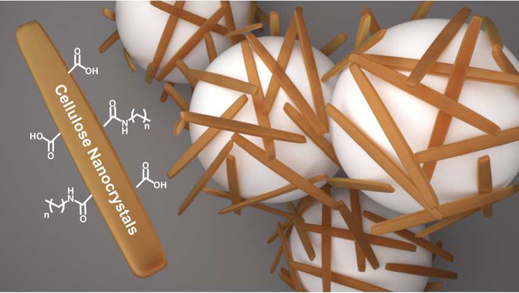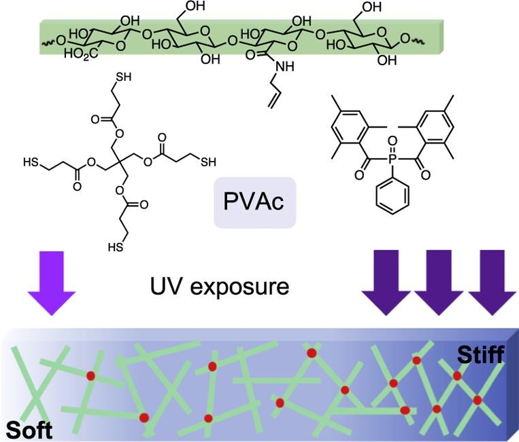Cellulose nanocrystals (CNCs) are bio-sourced, nano-scale particles commonly used for reinforcing plastics. Since cellulose is the most abundant polymer on the planet and can be found in almost every plant and even some animals, it exists as a sustainable way to improve material properties for a wide range of applications. In the Rowan lab, research is focused on expanding the use of CNCs with fully-sustainable plastics, bio-inspired materials, improved processing techniques, and many more applications (water, energy). This is done through the chemical modification of the CNC surfaces with polymers and small molecules, incorporation of the nanomaterial into a wide variety of one-, two-, and multi-component composites, and thorough characterization of the resulting materials.
Current Projects
Plastic pollution into oceans has become a huge problem and one possible solution is the development of new bio-sourced and biodegradable plastics. Unfortunately, many current bio-plastics do not have the mechanical properties necessary to succeed in commercial applications. This is why the Rowan group is trying to use bio-sourced CNC fillers to improve the properties of green plastics. Through chemical modification of the CNCs and careful processing, enhanced, fully sustainable composite materials are being developed for broad plastic applications.
The Rowan group is designing CNC-based polymer composites to create materials inspired by the architecture and mechanical properties of the materials found in nature. For example, the squid beak exhibits a large mechanical gradient along its length, connecting its high-modulus beak tip to the soft tissues of its mouth. By controlling the extent of covalent bonding between CNC fillers and polymer matrices, we are able to mimic the mechanical bridging characteristics of the squid beak.
Efficient reinforcement of nanocomposite materials is determined by the quality of the dispersion of CNCs within the polymeric matrix, with more homogeneous dispersions leading to better reinforcement. However, the hydrophilicity of CNCs can induce their aggregation in hydrophobic polymer matrices. The resulting phase segregation of the CNCs and the host matrix hinders processing and drastically decreases mechanical reinforcement. The Rowan group is tackling this challenge by taking advantage of dynamic covalent chemistry under solvent-free melt conditions. The strategy relies on melt processing of the CNCs with a dynamic polymer matrix, which during thermal processing releases reactive functional groups that react with the CNCs. Such CNC in situ functionalization is expected to allow a direct access to homogeneous composite materials with better mechanical properties.
Selected Publications
Abstract:
With a goal of identifying a new scalable source for cellulose nanocrystals (CNCs), we successfully isolated CNCs from a sustainable, non-invasive grass, Miscanthus x. Giganteus (MxG). Subjecting MxG stalks to base hydrolysis, bleaching and acid hydrolysis allowed access to cellulose nanocrystals (MxG-CNC) in high yields. X-ray diffraction studies showed the crystallinity of the MxG-CNCs increased with subsequent treatment conditions (>90% after HCl hydrolysis). Transmission electron microscopy showed that the MxG-CNC exhibit relatively high aspect ratios (60-70), and small angle neutron scattering showed the crystals were ribbon-like with a width and thickness of 8.5 and 2.8 nm respectively. As expected, thermomechanical analysis of nanocomposites fabricated with carboxylic acid functionalized MxG-CNC (MxG-CNC-COOH) and PVAc showed an increase in modulus (above Tg) as filler content was increased. Comparing the properties to PVAc nanocomposites containing CNCs from wood showed at least as good, if not slightly better, reinforcement at the same loading level.
Abstract:
Carboxylic acid cellulose nanocrystals (CNC-COOHs) that have been covalently functionalized (via peptide coupling chemistry) with a range of different hydrophobic groups have been investigated as nanoparticle surfactants to stabilize styrene-in-water nanoemulsions. It is shown that the size and stability of these nanoemulsions depend on both the amount of surface carboxylic acid groups as well as the amount and type of hydrophobic alkyl groups on the CNC surface. Two different biosources for the CNCs, microcrystalline cellulose (MCC) and Miscanthus x. Giganteus (MxG), were investigated to see the effect that the CNC aspect ratio has on these nanoemulsions. Stable oil-in-water (o/w) Pickering emulsions with particle diameters of only a few hundred nanometers can be accessed using these hydrophobic functionalized CNCs, and the resulting emulsions can be polymerized to access nanometer sized latexes. The hydrophobic/hydrophilic balance of the functionalized CNCs was found to be critical to lower the interfacial tension between oil and water, which allowed access to stable emulsions with droplet diameters <1 μm. The ability to stabilized nanosized emulsions and latexes extends the potential of CNCs as green surfactants for numerous technological applications, such as food, cosmetics, drug delivery systems, and coatings.

Abstract:
Photo-induced thiol-ene crosslinking of allyl-functionalized cellulose nanocrystal (CNC)/polymer nanocomposites allows access to films that mimic the water-enhanced mechanical gradient characteristics of the squid beak. These films are prepared by mixing the functionalized CNCs and polymer in a solvent before solution casting and drying. The photocrosslinking agents are then imbibed into the film before UV exposure. Reported herein are studies aimed at better understanding the effect of the film preparation procedure, film thickness and the conditions under which the UV treatment is carried out. It was found that when the film is heated at a temperature higher than its glass transition temperature (Tg) during the UV irradiation step there is a greater enhancement in the mechanical properties of the films, presumably on account of more efficient crosslinking between the CNC fillers. Moreover, composite films that were compression molded (at 90 °C) before the imbibing step displayed lower mechanical properties compared to the as-cast films, which is attributed to phase separation of the CNC fillers and polymer matrix during this additional processing step. Finally, the film thickness was also found to be a critical factor that affects the degree of crosslinking. For example, thinner films (50 µm) displayed a higher wet modulus ca. 130 MPa compared to ca. 80 MPa for the thicker films (150 µm). Understanding the processing conditions allows access to a larger range of mechanical properties which is important for the design of new bio-inspired mechanical gradient nanocomposites.

Abstract:
Cellulose nanocrystals (CNCs) are an emergent, sustainable nanomaterial that are biosourced, abundant, and biodegradable. On account of their high aspect ratio, low density, and mechanical rigidity, they have been employed in numerous areas of biomedical research including as reinforcing materials for bone or tissue scaffolds or as carriers in drug delivery systems. Given the promise of these materials for such use, characterizing and understanding their interactions with biological systems is an important step to prevent toxicity or inflammation. Reported herein are studies aimed at exploring the in vitro and in vivo effects that the source, length, and charge of the CNCs have on cytotoxicity and immune response. CNCs from four different biosources (cotton, wood, Miscanthus x Giganteus, and sea tunicate) were prepared and functionalized with positive or negative charges to obtain a small library of CNCs with a range of dimensions and surface charge. A method to remove endotoxic or other impurities on the CNC surface leftover from the isolation process was developed, and the biocompatibility of the CNCs was subsequently assayed in vitro and in vivo. After subcutaneous injection, it was found that unfunctionalized (uncharged) CNCs form aggregates at the site of injection, inducing splenomegaly and neutrophil infiltration, while charged CNCs having surface carboxylates, sulfate half-esters, or primary amines were biologically inert. No effect of the particle source or length was observed in the in vitro and in vivo studies conducted. The lack of an in vitro or in vivo immune response toward charged CNCs in these experiments supports their use in future biological studies.
